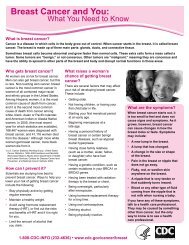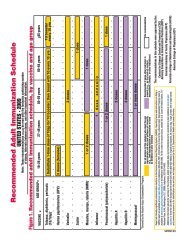Infertility Nursing - Omnia Education
Infertility Nursing - Omnia Education
Infertility Nursing - Omnia Education
You also want an ePaper? Increase the reach of your titles
YUMPU automatically turns print PDFs into web optimized ePapers that Google loves.
tHE OMnia cME JOURnal tm | sEPtEMBER 2011<br />
Elective Single Embryo Transfer<br />
and the Patient Demands<br />
When discussing the topic of<br />
elective single embryo transfer<br />
(esEt) with patients, it is<br />
extremely important to confirm patient<br />
expectations and demands. as health<br />
professionals it is important to educate<br />
our patients and make certain they have<br />
realistic expectations. it is also important<br />
to be aware of the facts about the rising<br />
number of multiple births and the risks<br />
which are avoidable in many cases, as well<br />
as the increasing success rates of esEt.<br />
deciding whether to offer esEt depends<br />
on the clinical judgment of the health<br />
care practitioners involved. the decision<br />
should be based on an assessment of the<br />
risk of multiple births to the individual<br />
patient, taking into account their overall<br />
prognosis. When a patient is considering<br />
fertility treatment they will have many<br />
questions about the potential outcome<br />
including the risk of multiple births. it is<br />
important to answer questions about how<br />
esEt may affect the patient’s chances<br />
of getting pregnant. in addition patients<br />
must be informed about what will be<br />
done with remaining viable embryos<br />
and how they will be stored, as well as<br />
cost of cryopreservation and storage of<br />
remaining embryos.<br />
Which patients are suitable for<br />
Elective Single Embryo Transfer<br />
(eSET)?<br />
Making the decision about doing an<br />
esEt depends on a patient’s prognosis<br />
for getting pregnant after iVF. the<br />
woman with the best chance of getting<br />
pregnant after iVF is also at the highest<br />
risk of conceiving multiples.<br />
Relevant factors to consider include<br />
the following:<br />
• Patient’s age and general medical<br />
condition<br />
• Obstetric and gynecological history<br />
• number of previous failed iVF attempts<br />
• the patient’s ovarian response<br />
• the number and quality of embryos<br />
created<br />
• the availability of good quality embryos<br />
including blastocysts<br />
the importance of the overall prognosis<br />
cannot be understated. the american<br />
society for Reproductive Medicine<br />
(asRM) has identified “favorable<br />
prognosis patients” as those under 37<br />
years of age (or using an oocyte donor<br />
under 37 years of age) without prior failed<br />
iVF cycles, who have morphologically<br />
good-quality embryos in sufficient<br />
number to warrant cryopreservation of<br />
the non-transferred embryos. 1<br />
Furthermore, esEt is not just for patients<br />
under 37 years of age. the Human<br />
Fertilization and Embryology authority<br />
(HFEa), an independent regulating<br />
authority in the United Kingdom that<br />
oversees the use of gametes and<br />
embryos both in fertility treatment as<br />
well as research, has posted success<br />
rates for esEt for 2004 and 2005. 2,3<br />
these indicate live birth rates of 23.7%<br />
and 18% retrospectively for patients<br />
over the age of 35, compared with the<br />
figures of 23.8% and 22.4% for the under<br />
35. the HFEa also suggests that esEt<br />
can be successfully performed in older<br />
patients, 35–39 years, with good quality<br />
embryos. the number of previously<br />
failed iVF attempts needs to be taken<br />
author<br />
Adrienne Kramer, rn, rnc<br />
Senior Nurse Coordinator<br />
Reproductive Medical Associates<br />
of New Jersey<br />
morristown, nj<br />
peer reviewers<br />
Sanjay K. Agarwal, md, facog<br />
Clinical Professor of Reproductive Medicine<br />
University of California, San Diego<br />
la jolla, ca<br />
Eric S. Surrey, md, facog<br />
Medical Director<br />
Colorado Center for Reproductive Medicine<br />
lone tree, co<br />
medical editor<br />
Erem Latif, ms, medical physiology<br />
Medical Editor<br />
chantilly, va<br />
into consideration equally when targeting<br />
esEt to the right patients. this means<br />
that esEt is normally restricted to the<br />
first one to two iVF cycles regardless of<br />
the age of the patient.<br />
Recent international studies have been<br />
carried out using the following criteria:<br />
• Women under 34 who started their first<br />
iVF/intra-cytoplasmic sperm injection<br />
(icsi) cycle and had at least two good<br />
quality embryos.<br />
• Women of all ages who had at least 4<br />
good quality embryos and no more than<br />
one failed treatment cycle.<br />
• Women under 36 years of age who had<br />
at least 2 good quality embryos.<br />
the asRM developed guidelines<br />
detailing the number of embryos<br />
transferred. 1 Multiple-gestation<br />
pregnancies remain the most significant<br />
and frequent complication of iVF<br />
treatment. although national and<br />
international efforts have focused on<br />
phasing out protocols that result in





